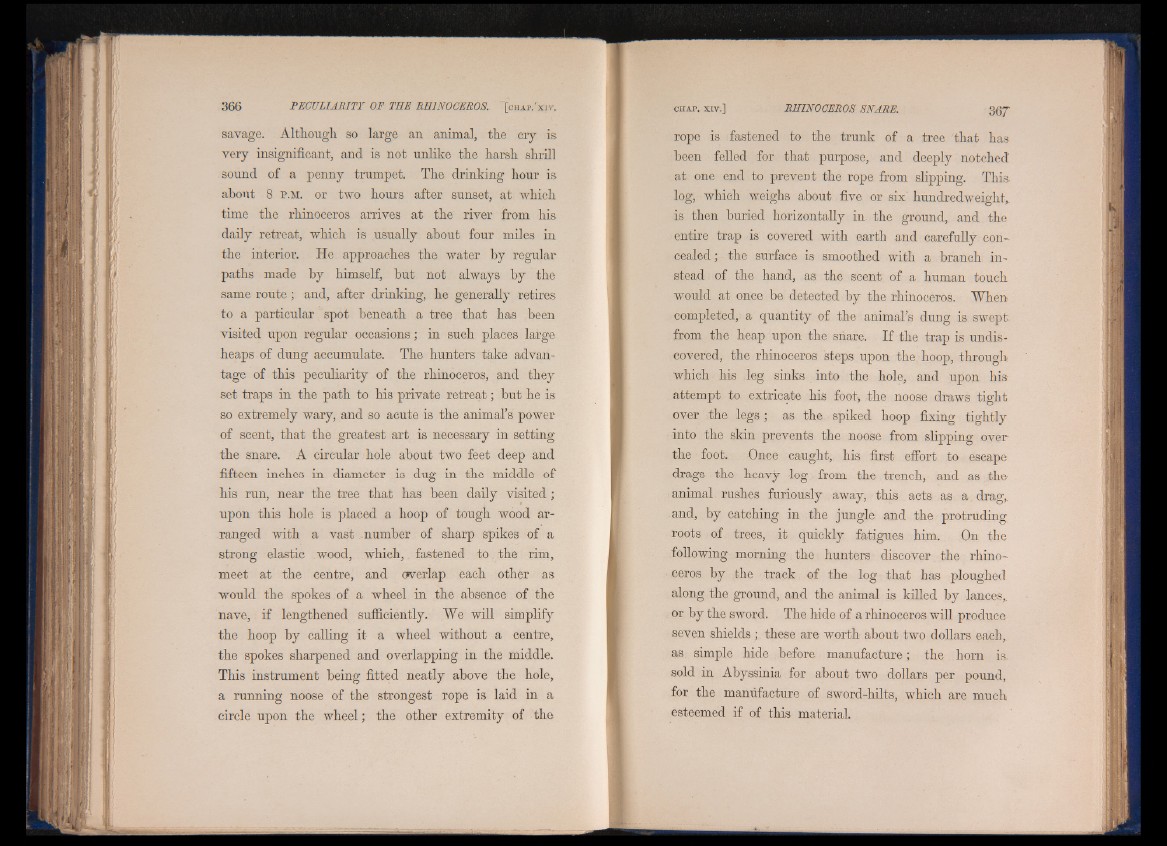
savage. Although so large an animal, the cry is
very insignificant, and is not unlike the harsh shrill
sound of a penny trumpet. The drinking hour is
about 8 P.M. or two hours after sunset, at which
time the rhinoceros arrives at the river from his
daily retreat, which is usually about four miles in
the interior. He approaches the water by regular
paths made by himself, but not always by the
same route; and, after drinking, he generally retires
to a particular spot beneath a tree that has been
visited upon regular occasions; in such places large
heaps of dung accumulate. The hunters take advantage
of this peculiarity of the rhinoceros, and they
set traps in the path to his private retreat; but he is
so extremely wary, and so acute is the animal’s power
of scent, that the greatest art is necessary in setting
the snare. A circular hole about two feet deep and
fifteen inches in diameter is dug in the middle of
his run, near the tree that has been daily visited ;
upon this hole is placed a hoop of tough wood arranged
with a vast number of sharp spikes of a
strong elastic wood, which,, fastened to the rim,
meet at the centre, and overlap each other as
would the spokes of a wheel in the absence of the
nave, if lengthened sufficiently. We will simplify
the hoop by calling it a wheel without a centre,
the spokes sharpened and overlapping in the middle.
This instrument being fitted neatly above the hole,
a running noose of the strongest rope is laid in a
circle upon the wheel; the other extremity of the
rope is fastened to the trunk of a tree that has
been felled for that purpose, and deeply notched
at one end to prevent the rope from slipping. This
log, which weighs about five or six' hundredweight,,
is then buried horizontally in the ground, and the
entire trap is covered with earth and carefully concealed
; the surface is smoothed with a branch instead
of the hand, as the scent of a human touch
would at once be detected by the rhinoceros. When
completed, a quantity of the animal’s dung is swept
from the heap upon the share. If the trap is undiscovered,
the rhinoceros steps upon the hoop, through
which his leg sinks into the hole, and upon his-
attempt to extricate his foot, the noose draws tight
over the legs; as the spiked hoop fixing tightly
into the skin prevents the noose from slipping over
the foot. Once caught, his first effort to escape
drags the heavy log from the trench, and as the
animal rushes furiously away, this acts as a drag,,
and, by catching in the jungle and the protruding
roots of trees, it quickly fatigues him. On the
following morning the hunters discover the rhinoceros
by the track of the log that has ploughed
along the ground, and the animal is killed by lances,,
or by the sword. The hide of a rhinoceros will produce
seven shields; these are worth about two dollars each,
as simple hide before manufacture; the horn is.
sold in Abyssinia for about two dollars per pound,
for the manufacture of sword-hilts, which are much
esteemed if of this material.